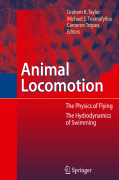
This book provides a wide-ranging snapshot of the state-of-the-art in experimental research on the physics of swimming and flying animals. The resulting picture reflects not only upon the questions that are of interest in current pure and applied research, but also upon the experimental techniques that are available to answer them. Doubtless, many new questions will present themselves as the scope and performance of our experimental toolbox develops over the coming years. Reports recent experimental investigations into the physics of animal locomotion Contributes to the applicability of the principles of animal flying and swimming to biomimetics Written from the experts in this field INDICE: A harmonic model of hydrodynamic forces produced by a flapping fin.- A potential-flow, deformable-body model for fluid–structure interactions with compact vorticity: application to animal swimming measurements.- Do trout swim better than eels? Challenges for estimating performance based on the wake of self-propelled bodies.- Fish locomotion: kinematics and hydrodynamics of flexible foil-like fins.- Flapping flexible fish.- Flowfield measurements in thewake of a robotic lamprey.- Fluid dynamics of self-propelled microorganisms, from individuals to concentrated populations.- Impulse generated during unsteady maneuvering of swimming fish.- Investigation of flow mechanism of a roboticfish swimming by using flow visualization synchronized with hydrodynamic force measurement.- Powered control mechanisms contributing to dynamically stable swimming in porcupine puffers (Teleostei: Diodon holocanthus).- Swimming by microscopic organisms in ambient water flow.- Time resolved measurements of the flow generated by suction feeding fish.- Vortex dynamics in the wake of a mechanical fish.- Wake visualization of a heaving and pitching foil in a soap film.- Water-walking devices.- Aerodynamic and functional consequences of wing compliance.- Aerodynamics of intermittent bounds in flying birds.- Characterization of vortical structures and loads based on time-resolved PIV for asymmetric hovering flapping flight.- Design and development considerations for biologically inspired flapping-wing micro air vehicles.- Experimental analysis of the flow field over a novel owl based airfoil.- Experimental investigation of a flapping wing model.- Experimental investigation of some aspects of insect-like flapping flight aerodynamics for application to micro air vehicles.- High-fidelity simulations of moving and flexible airfoils at low Reynolds numbers.- High-speed stereo DPIV measurement of wakes of two bat species flying freely in a wind tunnel.- PIV-based investigations of animal flight.- Shallow and deep dynamic stall for flapping low Reynolds number airfoils.- Smoke visualization of free-flying bumblebees indicates independent leading-edge vortices on each wing pair.- The aerodynamic forces and pressure distribution of a revolving pigeon wing.- The influence of airfoil kinematics on the formation of leading-edge vortices in bio-inspired flight.- Time-resolved wake structure and kinematics of bat flight.- Unsteady fluid–structure interactions of membrane airfoils at low Reynolds numbers.- Wake patterns of the wings and tail of hovering hummingbirds.- Wing–wake interaction reduces power consumption in insect tandem wings.
- ISBN: 978-3-642-11632-2
- Editorial: Springer
- Encuadernacion: Cartoné
- Páginas: 350
- Fecha Publicación: 01/05/2010
- Nº Volúmenes: 1
- Idioma: Inglés
